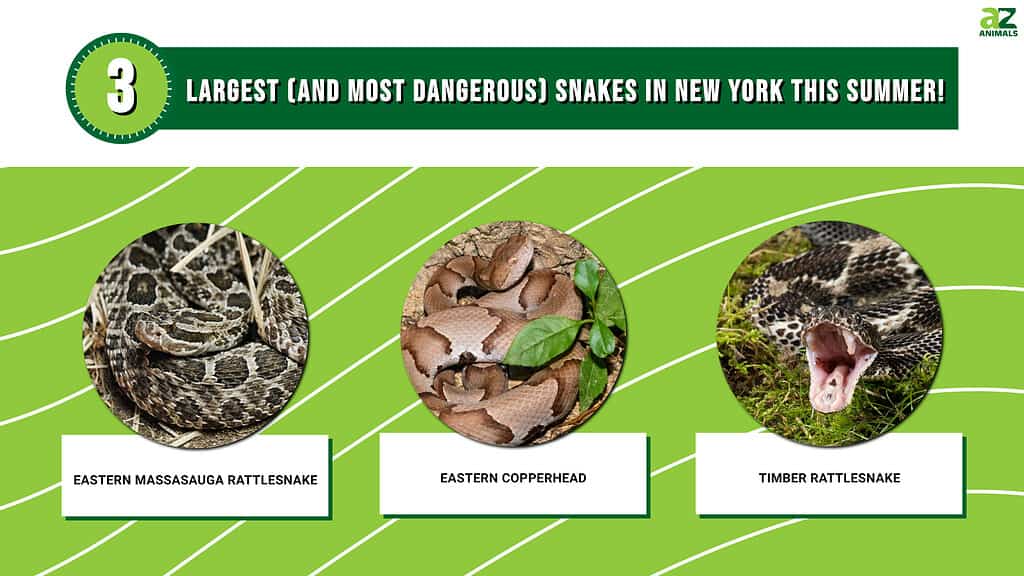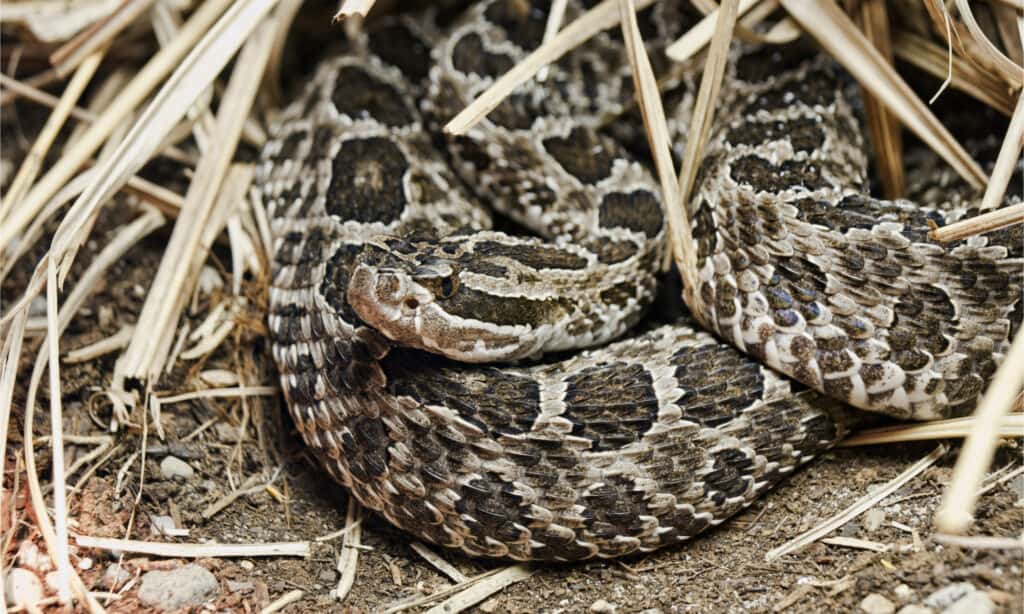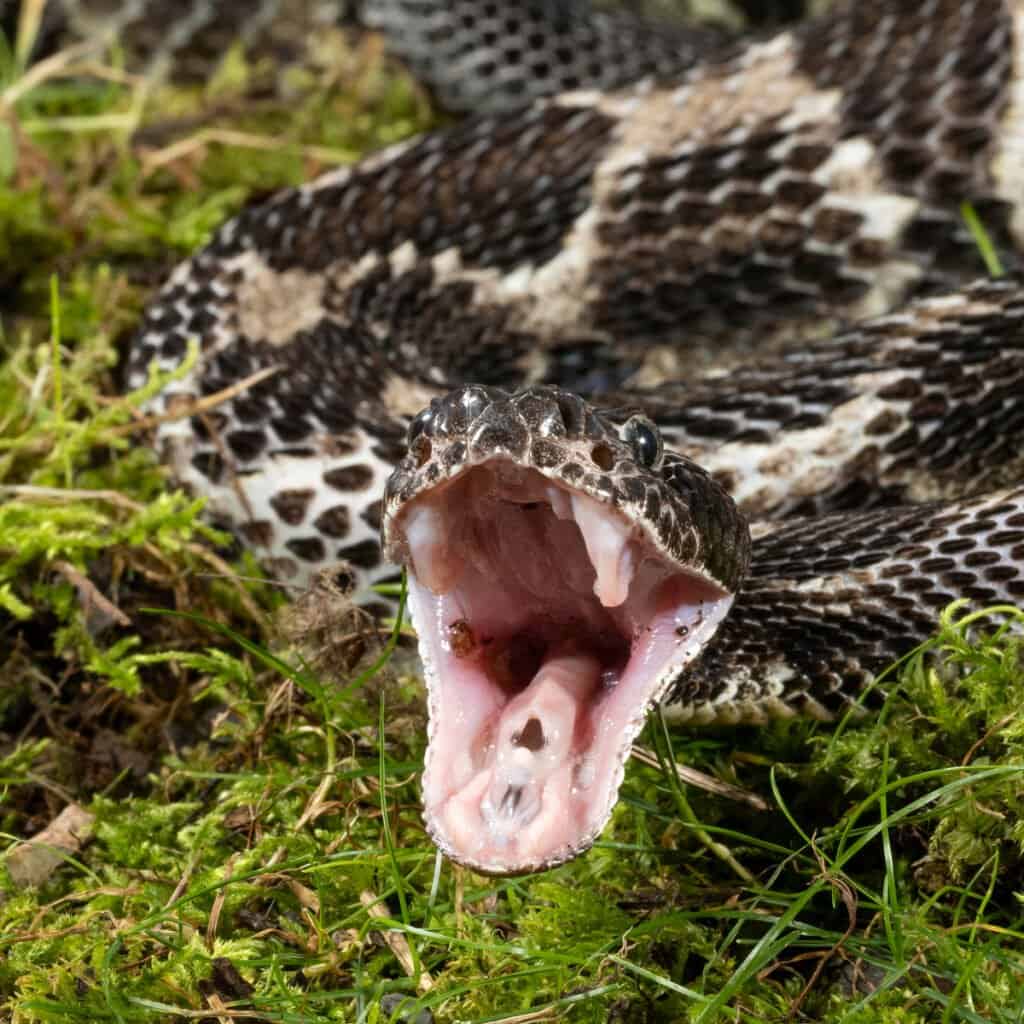
New York State is the home of around seventeen species of snakes, all of which play a huge part in maintaining the ecosystem of their areas. Snakes are population control for small rodents and other invasive pests and provide food to larger predators as well. However, many snake species are dangerous to humans, and stumbling upon one of these venomous species can cause severe injuries or even be fatal. In New York, there are only three common venomous snake species, the eastern copperhead, the eastern Massasauga rattlesnake, and the timber rattlesnake. But which one is the biggest, most dangerous snake in the state?

There are only three venomous snakes common in New York State, the Timber rattlesnake, the Eastern Copperhead, and the Eastern Massasauga rattlesnake shown above.
©Ryan M. Bolton/Shutterstock.com
The Three Largest (And Most Dangerous) Snakes In New York City
While all three of the largest, most dangerous snakes in New York are potentially deadly, all of them are considered an uncommon sight. As a species, snakes tend to avoid us and prefer habitats away from where they feel threatened. Most snake bites occur due to accidental contact and being aware of the habitats where venomous snakes are found can prevent a bite. It is also crucial to know which venomous species can be found in your area, as well as what they look like.
In the state of New York, there are only three venomous snakes considered to be common. Even these species are a rare sight in urban or suburban areas, and many are only found in certain locations. We will start with the smallest of the three, the eastern Massasauga rattlesnake.
The Eastern Massasauga Rattlesnake

The Eastern Massasauga rattlesnake is only found in the Bergan Swamp and the Oneida Swamplands of New York.
©DnDavis/Shutterstock.com
| Size | 12-36 inches |
| Habitat | Wetlands, near water sources |
| Threat | Moderately dangerous, the venom can cause life-threatening or disabling health problems if left untreated |
| Behavior | Moderately aggressive, most bites occur through accidental contact |
Eastern Massasauga rattlesnakes can be identified by their tan, grey, or brown coloring with darker hourglass-shaped spots. Other identifying markings include a pattern of three small brown spots along the back. They have thicker bodies and heart-shaped heads.
This species is only found in the Bergen Swamp close to Rochester and the Oneida Swamplands to the east of Syracuse. Due to continued threats to the subspecies’ habitat, they may be considered endangered very soon.
The Eastern Copperhead

The Eastern Copperhead is rarely found outside of the upper regions of the Hudson Valley in New York, with scattered populations that are limited to the Southeastern regions of the state.
©Jeff W. Jarrett/Shutterstock.com
| Size | 24-38 inches long |
| Habitat | Rocky or high elevations and marshlands in fallen leaves or wood piles. |
| Threat | Bites can be dangerous if left untreated |
| Behavior | Rarely attack if unprovoked but will strike without warning. Bites occur due to accidental contact |
Eastern Copperheads can be identified by their reddish-brown or green coloring and darker hourglass markings along the back. Additionally, the copperhead’s namesake is its distinct copper-colored head, which is the species’ most distinct identifier.
Copperheads are most found in the Hudson Valley but are far more common in the lower regions. Their range is mostly limited to the southeastern parts of New York and is a rare sight in the western areas of the state. Copperheads are reclusive and rarely encountered in cities or towns. Due to their appearance, they blend seamlessly into ground cover and vegetation.
Timber Rattlesnake

The Timber Rattlesnake is located primarily in the Southeastern parts of New York State, and is classified as a Threatened species due to commercial capture.
©Joe McDonald/Shutterstock.com
| Size | 36-60 inches long |
| Habitat | Forests, farms, lowlands |
| Threat | Deadly To humans without prompt medical treatment |
| Behavior | Moderately aggressive ambush hunter that gives little warning before striking. |
The largest and most dangerous snake in New York is the timber rattlesnake. Timber rattlesnakes can be identified by their brown-banded body with a reddish tint and their yellow/grey and black markings. This species has the most concentrated and deadly venom of any United States snake, including the eastern diamondback rattlesnake.
The timber rattlesnake can be spotted throughout the southeastern parts of the state. There are also scattered populations in the southern tier of western New York. This species is classified as Threatened by the state due to bounties and commercial capture for its skin or in the pet trade.
What To Do If You Are Bitten By A Venomous Snake

Even though there are only three species of venomous snakes found in New York, everyone should know what to do, and what NOT to do, if bitten by a snake!
©Joe McDonald/Shutterstock.com
There are three million reports of snake bites every year worldwide, and only a fraction of them proves fatal. However, even a non-fatal bite from a venomous snake can leave you with permanent health problems or disabilities. Detection of a dangerous bite can be challenging, as each species’ venom can cause different reactions in the human body. For example, a rattlesnake bite becomes red and painful within moments, but those symptoms may take much longer to appear in a copperhead bite. Therefore, all snake bites should be treated like venomous bites!
What To Do If A Snake Bites You
If a snake bites you, it is crucial that you know how to handle the situation. Having the right information will do more than make the situation easier, it can save your life. The most dangerous thing about being bitten is the understandable fear and panic response. As in all dangerous situations, knowledge is power. Being well informed is always the first step in knowing what to do, and more importantly, what not to do, when dealing with a snake bite!
What NOT To Do When Bitten By A Snake
Despite what many books, TV shows, and movies may have taught us all about snakes, many of these old beliefs are incorrect. It is important to note that the effects of snake venom differ both by species, as well as by where they are in the world. Every species has its own cocktail of toxins that may need specific antivenom to treat. While one continent may have ready access to the antivenom for species in their area, another may not.
Below is a list of what you should not do when you think you have been bitten by a venomous snake in North America:
- Do Not Use A Tourniquet On A North American Bite: North American snakes produce venom that causes increased bleeding. Applying a tourniquet can result in tissue damage and muscle necrosis. This may mean skin grafts or amputation.
- Do Not Try To Suck The Venom Out: When venomous snakes bite, those toxins rapidly spread throughout the surrounding tissues. It is impossible to suck out the venom and may even make the situation worse.
- Do Not Attempt To Cut The Venom Out: In addition to being as ineffective as attempting to suck out the venom, attempting to slice into the wound will also do more harm than good. This adds the additional danger of blood loss, severe injury, or infection.
- Do Not Apply Ice Or Hot Compresses: This may seem like a promising idea, as snake bites often become red, swollen, or inflamed. However, not only do these measures fail to help, but they may also worsen the problem
- Do Not Use Steroids: Some individuals administer their own veterinary care to livestock and may have steroids on hand. Using steroids to treat a venomous snake bite could worsen the problem and may be fatal.
What To Do When Bitten By A Snake
When you or another individual is bitten by a snake, the most important thing is to treat every bite like a venomous bite. Always seek medical treatment immediately, and never attempt to treat a snake bite yourself! While waiting for emergency services to arrive, experts recommend taking the following steps:
- Get Away From The Snake: The first thing to do is to get as far from the snake as possible. Do not attempt to catch the snake or eliminate it. This will only result in further injury.
- Keep The Wound Clean: Clean the wound and the surrounding area with soap and water or alcohol to minimize the risk of infection. Remember, do not wrap the wound as this may cut off circulation.
- Elevate The Wound: Keep the bite elevated above the heart to reduce the venom’s effects.
- Stay Calm And Still: Reduce movement as much as possible and stay calm. Once you are away from the snake stay where you are and wait for help.
- Monitor Heart Rate: Keep an eye out for increased heart rate, if possible, to report accurately to emergency personnel
The photo featured at the top of this post is © Rusty Dodson/Shutterstock.com
Discover the "Monster" Snake 5X Bigger than an Anaconda
Every day A-Z Animals sends out some of the most incredible facts in the world from our free newsletter. Want to discover the 10 most beautiful snakes in the world, a "snake island" where you're never more than 3 feet from danger, or a "monster" snake 5X larger than an anaconda? Then sign up right now and you'll start receiving our daily newsletter absolutely free.
Thank you for reading! Have some feedback for us? Contact the AZ Animals editorial team.






